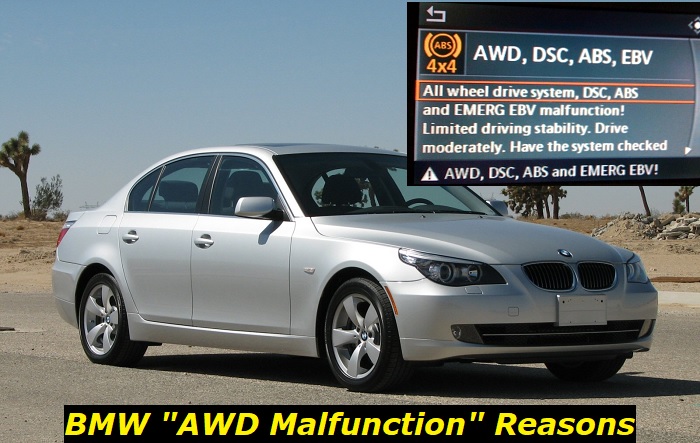BMW is a brand well known around the world for its cutting-edge designs, technologies, and engineering. Along with being one of the top brands for those who love speed, power, and performance, BMW also holds an excellent position in the AWD market.
AWD malfunction message highlights
- Common reasons:wheel-speed sensor issues, traction control problems, AWD problems
- How to fix:scanning for codes and checking the reported units
- Possible consequences:if ignored, the problems may actually destroy the differential and other AWD units
- Priority level:High
- Can you drive?Carefully
- DIY repair:Impossible
- Repair price range:$150-$2,000

In case your BMW is showing an AWD error, it can mean either your AWD (xDrive) is completely malfunctioning or there may be a failure with another related component.
If you are a BMW owner having trouble with your all-wheel-drive, or if the AWD malfunction error is flashing, there is no need to panic. We will discuss the function of your AWD and go through some common reasons that may cause your BMW's AWD system to malfunction. Therefore, you will be able to see which of the blow situations your BMW might fall into and have it fixed by a professional mechanic.
BMW's AWD System (xDrive)
All-wheel-drive systems are getting much more sophisticated, compact, and lighter. As a result, they have been becoming progressively popular and are found in luxury vehicles, performance cars, and sedans. As many other renowned manufacturers have their version of the all-wheel-drive system, BMW has its unique way of handling its AWD and stability controls with its intelligent xDrive.
The all-wheel-drive along with the Dynamic Stability Control (DSC) system increases the traction of your BMW and improves the performance and reliability of your vehicle. These systems make your BMW easier to handle and play a huge role in keeping the BMW under control and safe during tough driving conditions.
The AWD system is capable of delivering power to all four wheels with electronic sensors to determine the wheel with the most grip to avoid skidding or losing control in hazardous situations.
The xDrive is BMW's intelligent all-wheel drive system that was introduced through various models back in 2003 and still continues to dominate in the competitive market of vehicles equipped with the AWD system.
This AWD system uses an electronically controlled clutch pack and is capable of automatically transferring power to the wheels with the most grip to ensure the best possible control. The xDrive, with assistance from the DSC and forgoing sensors, continuously monitors your BMW's traction on the road and is ready to adjust to any changing conditions on that road at any moment.
This intelligent and permanent all-wheel drive system works to keep you safe under precarious driving conditions while providing smooth and sporty performance. While a default 60/40 split gives your BMW energy-efficient power, the xDrive is a fully variable system that can direct a 100:0 split to either axle if needed.
Your BMW can automatically adjust the power distribution to either front or rear axles within one-tenth of a second with the help of its innovative variable torque split.
What causes AWD to Malfunction In BMW
The all-wheel drive helps enhance agility, provides unbelievable traction, and keeps you safe behind the wheels. The xDrive can adjust to dangerous road conditions and return to its default settings without you even realizing or sensing any danger of losing control.
However, when such an AWD system that is always monitoring your every move on the road suddenly stops working, that can disrupt your driving habits and put you in a very vulnerable position.
With your AWD malfunctioning, that could result in you losing control of your vehicle and finding yourself in a very unsafe operational condition. Sudden speed changes, drifting issues, and loss of control are some common telltale signs of your AWD malfunctioning and can be extremely dangerous.
That is why it is important to know what can cause your AWD to malfunction so that you can get it serviced by an expert mechanic immediately.
- Transfer Case Failure
BMW's driving dynamics have been taken to a new level with the advanced all-wheel-drive system. The intelligent xDrive system can help your BMW get through almost any type of conditions you can imagine including mud or even slushy snow-covered roads.
If your AWD system fails or any of the components are unable to function, you will probably be warned with a warning signal illuminating on the dashboard.
One very common reason that can cause the AWD system in your BMW to malfunction is due to the transfer case failure. The transfer case is responsible for transporting the power generated by the transmission to the correct axles of the vehicle. Although it is a common issue, transfer case failure can put a restraint on your driving experience.
In a BMW, it is an essential task to keep all the wheels of the vehicle working properly with one another. With assistance from the drive shaft, the transfer case ensures that the transmission's generated power goes to the appropriate axles. Without the transfer case functioning properly, your BMW will end up with some very risky performance and handling issues.
Odd or unusual noises coming from the engine or gear shifting issues are some common symptoms of transfer case failure. Left unattended will not only cause further damage to your vehicle but may also put you in a compromising driving situation.
So, if you are experiencing any issues with your transfer case, you must take your vehicle to a BMW specialist right away to restore your vehicle and avoid risky situations that may lead to serious accidents.
- The Transfer Case Oil
When it comes to maintenance, one of the main maintainable components for the xDrive is the transfer case oil. The transfer case oil is crucial for the advanced all-wheel-drive system to function properly and can last from 50k to 150k miles, depending on your driving style. Most problems related to the xDrive in your BMW are a direct result of worn transfer case oil.
One of the tell-tale signs of worn transfer case oil is that your BMW may jerk during hard acceleration. It can also cause severe damage as worn transfer case oil will eventually demolish the front CV joints and shafts. The oil change period is determined by calculating the slippage of transfer case clutches, which is done by your BMW's computers.
- Damaged/Poor Electrical Connection
When you start your vehicle, the battery's responsibility is to send electricity to the starter and to the spark plugs for your BMW to start up. However, once your BMW has started and the engine is running, the battery's job is complete. After that, the alternator takes over working as a generator to continue generating electricity for your vehicle.
This electricity is sent down through lengthy wires to various components in your BMW, including all related parts and sensors linked to your AWD system (xDrive). If any of these parts fail, it will directly affect the AWD system and cause the error sign to come on your dashboard. Blown fuse and wire damages are the most common culprits for damaged/poor electrical connections in your BMW.
- Faulty Wheel Speed Sensor
The AWD and DSC work hand to hand with continuous sensors to monitor your driving and road conditions. Therefore, faulty sensors in this complex system can cause the AWD and DSC malfunction warning lights to come on. The Wheel Speed Sensor, for example, is used to monitor that your BMW's tires are all spinning correctly.
If the wheel speed sensor happens to get damaged or simply fails to work, it will not be able to properly assess the rotation of the wheels on your vehicle. Without the sensor working properly, it will cause the AWD and the DSC to malfunction and most likely result in the warning light illuminating on the dashboard.
In case of faulty sensors, take your vehicle to a professional mechanic/garage, as replacing sensors in your BMW is a very complicated job and should not be done on your own.
- AWD and DSC System Needs to be Reset
There are times when your AWD and DSC malfunction signal may come on and just needs to be reset. The AWD is related to other sensors and is a very complex system where the AWD malfunction warning signal can illuminate without an actual AWD or DSC problem. Therefore, you may just need to reset your AWD and DSC system for it to return to its normal function.
Conclusion
BMW is known to be one of the most reliable, consistent, and high-performing brands in the global market. With their advanced and intelligent xDrive AWD system, they have really made a difference in the all-wheel-drive field. The AWD and the DSC systems in your BMW work together to ensure the best traction possible and adjust to any changing conditions on the road to keep you in complete control of your vehicle.
If you notice the AWD and DSC malfunction light illuminating on our dashboard, it is a strong indicator that something with your AWD system is not working properly. The AWD, along with the rest of the electrical systems in your BMW is extremely sophisticated and works together with other units to make your ride comfortable and safe.
Therefore, when experiencing any problematic symptoms relating to your AWD system, avoid taking matters into your own hands and get your BMW diagnosed immediately by a licensed mechanic.
About the authors
The CarAraC research team is composed of seasoned auto mechanics and automotive industry professionals, including individuals with advanced degrees and certifications in their field. Our team members boast prestigious credentials, reflecting their extensive knowledge and skills. These qualifications include: IMI: Institute of the Motor Industry, ASE-Certified Master Automobile Technicians; Coventry University, Graduate of MA in Automotive Journalism; Politecnico di Torino, Italy, MS Automotive Engineering; Ss. Cyril and Methodius University in Skopje, Mechanical University in Skopje; TOC Automotive College; DHA Suffa University, Department of Mechanical Engineering






Add comment